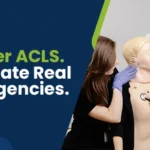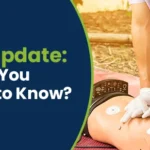Table Of Content(s)
- Introduction
- Overview of the Algorithm for Suspected Opioid Overdose
- Signs of Opioid Overdose
- Initial Assessment and Response
- Naloxone Administration: Dose and Delivery Routes
- ACLS Protocols for Opioid Overdose
- CPR in Opioid-Related Life-Threatening Emergencies
- Special Considerations in Opioid Overdose Management
- Post-Resuscitation Care and Follow-up
- Prevention Strategies and Education
- Final Thoughts
Opioids are strong medicines useful in treating pain when used correctly. However, these drugs can also be dangerous if misused or taken without a doctor’s guidance. Globally, it is estimated that in the year 2019, approximately 600,000 people died from the use of drugs, out of which opioids account for approximately 80%. In one of every four cases of overdose death, opioids are the cause. This shows how serious the problem of opioid misuse has grown.
To that extent, health professionals and first responders need to have a structured way forward when they suspect an individual has been overdosed on opioids. That is when the suspected opioid overdose algorithm comes in. It provides a structured approach to the assessment, treatment, and further care of individuals who overdose on opioids.
In this in-depth guide, we offer a step-by-step approach to identifying and treating possible opioid-associated life-threatening emergencies and ways to save lives in critical situations potentially.
Master ACLS Now
Get ACLS certified with confidence
Overview of the Algorithm for Suspected Opioid Overdose
Opioid overdose is a result of excessive unopposed stimulation of the opiate pathway that can cause decreased respiratory effort and can be fatal. The frequency of opioid overdose is rapidly increasing. On the domestic front, drug overdose is currently the leading cause of accidental death in the United States, and opioids are the most commonly involved drug.
The suspected opioid overdose algorithm is a step-by-step document that can help healthcare providers in the rapid identification and response of a patient who presents with a potential opioid overdose. It places much emphasis on the rapid assessment and naloxone administration, as well as the starting of life-saving interventions if necessary. Key steps in the algorithm include:
- Scene safety and initial assessment
- Assessment of responsiveness and breathing
- Opioid overdose activation of emergency medical services
- Naloxone administration
- Administration of rescue breathing or CPR, if required
- Continuation of care and monitoring
Signs of Opioid Overdose
Early recognition of opioid overdose is critical to enable the delivery of timely interventions. This includes the following signs and symptoms that the healthcare professional needs to be familiar with:
- Decreased level of consciousness or unresponsiveness
- Slow, shallow, or absent breathing
- Pinpoint pupils
- Cyanosis in which lips and nails turn bluish
- Slow heart rate
- Cold, clammy skin
Note: Not all of these signs are present in every overdose case. However, respiratory depression and changes in mental status must raise immediate red flags for opioid toxicity.
Initial Assessment and Response
Upon arriving at the scene of a potential opioid overdose, the first action should be to ensure scene safety, followed by conducting an initial assessment. This comprises the following:
- Checking for responsiveness through shouting and providing a sternal rub
- Check airway, breathing, and pulse
- Call 911 or activate emergency medical services if this has not already been done
- Place the patient in a position that will keep their airway open
If the patient is unconscious, is not breathing, or is only gasping, deploy an opioid-associated life-threatening emergency response.
Every second is extremely important in such situations. Quick, calm, and correct actions of a healthcare professional or a bystander can literally make the difference between life and death. This will provide the person with the maximum chance of survival until professional medical help is available.
Naloxone Administration: Dose and Delivery Routes
Naloxone, a generic name for Narcan, is the most commonly used antidote in the treatment of opioid overdose. When administered in time, naloxone can reverse the effects of the opioid almost instantly, thereby restoring breathing.
- Naloxone Dose ACLS:
- The initial dose recommended is 0.4 mg to 2 mg as an IV push,
- Repeat dose 2-3 minutes if no response,
- The maximum cumulative naloxone dose ACLS should be given in 10 mg.
- Naloxone or Narcan Dose IV ACLS:
- Initial dose: 0.4 mg to 2 mg as an IV push,
- This Narcan Dose IV ACLS can be repeat as needed 2-3 minutes,
- Continuous infusion should be considered if repeated doses are required.
- Methods of Administration:
- Intravenous—IV (preferred in the hospital setting),
- Intranasal is given via a nasal spray, which can be administered easily by non-medical personnel;
- Subcutaneous may be given if no IV access is available.
Note that the duration of action of naloxone is likely to be shorter than that of many opioids. Thus, patients should be monitored for the return of overdose symptoms, and repeat doses may be required.
Also Read: Amiodarone & ACLS
ACLS Protocols for Opioid Overdose
Advanced cardiac life support (ACLS) protocols are vital to managing critical opioid overdose, especially when patients are experiencing cardiac arrest or serious respiratory depression.
Essential elements of ACLS in opioid overdose:
- Airway Management:
- Open and maintain the airway,
- Consider advanced airway placement as indicated.
- Breathing Support:
- Provide rescue breaths or bag-valve-mask ventilation,
- Supplement oxygen as indicated.
- Circulation:
- Check pulse and initiate chest compressions if not present,
- Establish IV or IO access for medication administration.
- Defibrillation
- Attach a cardiac monitor and assess rhythm,
- Deliver shocks if indicated: ventricular fibrillation or pulseless ventricular tachycardia.
- Medications
- Naloxone, as per the suspected opioid overdose algorithm,
- Other ACLS medications, as indicated by the patient’s condition.
- Postresuscitation Care
- Continue monitoring and supportive care,
- Address the underlying causes and complications.
ACLS providers should be ready to treat potential complications of naloxone administration, such as acute withdrawal syndrome or acute pulmonary edema.
CPR in Opioid-Related Life-Threatening Emergencies
When facing an unresponsive patient with a suspected opioid overdose, CPR may be needed. The approach to CPR in opioid-related life-threatening emergencies integrates standard resuscitation strategies with unique considerations of opioid toxicity.
- Naloxone CPR protocol:
- Check for responsiveness and normal breathing,
- If unresponsive and not breathing normally, begin CPR,
- Administer naloxone as soon as possible as per the naloxone CPR protocol,
- Continue CPR until the patient responds or with the onset of advanced medical care.
- For Opioid Unresponsive CPR:
- Start 30 chest compressions,
- Deliver 2 rescue breaths,
- Continue 30:2 cycles of compressions to breaths,
- Administer naloxone when available when providing opioid unresponsive CPR,
- Re-assess after every dose of naloxone administered.
Also Read: Chest Compressions – The First Line Response
Special Considerations in Opioid Overdose Management
Several factors can complicate the management of opioid overdose and require special consideration:
- Polysubstance Use:
- Patients may have ingested multiple substances, which can alter the presentation and response to treatment,
- Be prepared to manage other toxidromes concurrently.
- Fentanyl And Ultra-Potent Opioids:
- May require higher or repeated doses of naloxone,
- Increased risk of recurrence of overdose symptoms.
- Withdrawal Precipitation:
- Rapid reversal with naloxone can precipitate acute withdrawal,
- Be prepared to manage agitation and other withdrawal symptoms.
- Chronic Pain Patients:
- Will have some degree of opioid tolerance, which may alter the response to naloxone,
- Consider partial reversal to avoid severe withdrawal while maintaining respiratory function.
- Pregnant Patients:
- Maternal resuscitation is the priority,
- Effects on the fetus must be considered.
- Pediatric Patients
- Dosing of naloxone based on weight,
- Consider non-opioid causes for altered mental status.
Healthcare providers should be prepared to individualize their approach based on these and other patient-specific factors.
Post-Resuscitation Care and Follow-up
Following successful resuscitation after an opioid overdose, there is a need for a continuum of care and monitoring. These are essential elements for post-resuscitation care:
- Continuous Monitoring:
- Vital signs, oxygen saturation, and level of consciousness
- Cardiac monitoring for at least 4-6 hours
- Supportive Care:
- Supplemental oxygen as necessary
- IV fluids for rehydration and electrolyte management
- Repeated Naloxone Administration:
- Consider continuous infusion for long-acting opioid overdoses
- Titrate to maintain adequate respiratory function
- Management of Complications:
- Treat pulmonary edema, if present
- Address any injuries sustained during the overdose or resuscitation
- Psychiatric Evaluation:
- Conduct assessments to identify signs of depression, anxiety, or other mental health disorders that may contribute to substance use.
- Create a safety plan that includes resources and support for individuals at risk of self-harm or suicidal thoughts.
- Addiction Treatment Referral:
- Provide information regarding addiction treatment options
- Facilitate referral to substance use disorder specialists
- Discharge Planning:
- Educate patients and caregivers about overdose prevention
- Naloxone kits and education for home use
Proper post-resuscitation care will not only reduce the chance of recurrent overdose but also help improve long-term outcomes for patients. Individuals should also be trained in basic life support skills for timely action in such emergencies.
Prevention Strategies and Education
Although the suspected opioid overdose algorithm is essential for acute overdose management, prevention is the key to ending the opioid crisis. Physicians have a duty and responsibility to their patients, families, and society to provide education on the safe use of opioids and overdose prevention. Prevention strategies include:
- Clearly appropriate practices in opioid prescribing
- Patient education regarding the safe use, storage, and disposal of opioids
- Promotion of nonopioid alternatives for pain
- Screening for SUDs and referring to treatment
- Naloxone distribution to at-risk people as well as families
- Education provided to communities on recognizing and responding to overdose
Thus, proper management with effective prevention efforts based on the model introduced by the Institute of Medicine is important. Through this, healthcare providers will be able to take giant steps toward a reduction in morbidity and mortality related to opioids.
Final Thoughts
The suspected opioid overdose algorithm is one of the most critical elements of management in opioid-associated, complex emergencies. Such a structured approach permits health professionals to assess, treat, and follow up efficiently with patients who have an overdose related to opioids. Critical elements in the algorithm include the prompt recognition of overdose signs, timely administration of naloxone, and ACLS protocols when appropriate.
In an environment within the opioid crisis, treatment for overdose must stay relevant. By pairing efficient acute care with comprehensive strategies for prevention, we can work to lessen the devastating toll of opioid overdose on individuals and families.







